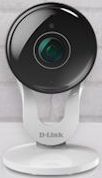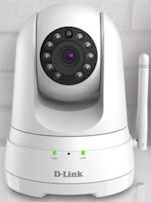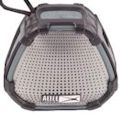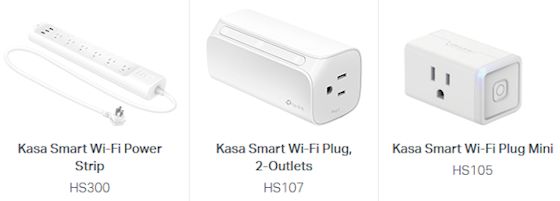Video cameras are becoming quite popular for do-it-yourself home security, with "smart home" products like the Ring Doorbell cameras and the Blink Indoor and Outdoor cameras (acquired by Amazon at the end of 2017). These are designed to monitor an area, send an alert if they detect activity, and post an associated video clip online.
These cameras are designed to be small and inexpensive, and so depend on the web for storage. As a result, they tend to capture relatively short clips, limit the amount of video storage, and/or charge a monthly fee for storing clips for longer periods. They're also not designed for extended live viewing.
But these security cameras are great for their purpose, and you can spend lots of time on YouTube watching clips of people who were successfully caught acting badly at front doors -- trying to break in, stealing packages, and hogging all the Halloween candy.
Another approach, taken by D-Link, is to build the intelligence and the storage into the camera, with online cloud storage as an option. These cameras detect activity, record clips to a local SD card, send alerts to your smartphone, and optionally upload the video to the cloud. Plus you can monitor them live, continuously, and record while watching, for example to keep an eye out on the driveway for an expected visitor or package delivery.
The D-Link cameras also provide a broad range of configuration options, through the mydlink app and web browser access, including remote viewing with zoom, split-screen to monitor multiple cameras, detection sensitivity (sound and/or motion), selecting zones within the view to monitor, alert types, and use of night vision lighting with IR LEDs. The app also works with Amazon Alexa (Fire TV) and Google Assistant (Chromecast).
The core D-Link line has four wireless cameras.

The base D-Link Mini HD Wi-Fi Camera for $59 (two for $99) is small cylindrical camera (3.6 inches tall) designed for indoor use, and which records only to the cloud.
It captures HD 720p video (1280 x 720), with a 120 degree field of view. It alerts on sound or motion, and the night vision IR LEDs illuminate up to 16 feet in complete darkness.

The D-Link HD Wi-Fi Camera for $59 is an adjustable camera with similar specs and about the same height, but stores video locally and optionally to the cloud.
It also not only records audio with video, but also has a speaker to support two-way conversations.

The D-Link Full HD Wi-Fi Camera for $79 then steps up to higher-res 1080p Full HD video (1920 x 1080).
It has a wider 130 degree field of view and is a bit taller at 4.3 inches.

Finally, there's the D-Link Full HD Pan & Tilt Wi-Fi Camera for $99.
This is a 1080p camera with 114 degree field of view. It's a bit chunkier at 4.38 x 5.26 x 4.58 inches, and 0.73 pounds.
Plus, it adds the ability to see a much wider area by remotely panning side by side to see behind (170 degrees to each side) and tilting it up and down (up 90 degrees to look straight up and down 20 degrees).
The D-Link setup process is relatively painless. You download the app, scan the QR code on the camera to identify it, and then set up the camera on your Wi-Fi network (done transparently through Bluetooth, so you don't need to manually mess around with settings). This worked successfully in most of my tests, although sometimes the app needed to re-try the Wi-Fi setup. Just watch out that there are multiple "mydlink" apps in the app stores (Lite, Home, etc.) -- you need "mydlink" without any modifiers.
Finally, D-Link does provide monthly plans for its cloud storage option, which are designed for extending storage for multiple cameras. You can store video for free for 24 hours, with up to 3 cameras. You can extend this to 7 days for $2.49 a month or $24.99 a year, or 14 days with 5 cameras for $4.99 / $44.99, up to 30 days with 10 cameras for $9.99 / $99.99.
Smart cloud security cameras are a great inexpensive alternative for alerting on activity in specific areas like the front porch. But for not much more you can get a more flexible camera that allows you to watch areas live, provides more flexible control over how it monitors, and stores and retains video locally without additional monthly costs.
- See full Holiday Tech 2018 presentation for my local talks in the Princeton area
- See companion article in U.S. 1 Newspaper, Nov. 14, 2018
 Find the D-Link Mini HD Wi-Fi Camera, HD Wi-Fi Camera,
Find the D-Link Mini HD Wi-Fi Camera, HD Wi-Fi Camera,
Full HD Wi-Fi Cam, and Pan & Tilt Wi-Fi Cam on Amazon

![]() Find the Panasonic LUMIX S1 and
Find the Panasonic LUMIX S1 and

 The next step is to add simple commands -- just by drawing patterns of colored dots (or using stickers) -- to have the Ozobot change speed, move in a direction, pause, count down until change, and perform pre-defined moves.
The next step is to add simple commands -- just by drawing patterns of colored dots (or using stickers) -- to have the Ozobot change speed, move in a direction, pause, count down until change, and perform pre-defined moves.  All this physical fun can then transition into programming using the OzoBlockly programming tool, which also runs in the browser.
All this physical fun can then transition into programming using the OzoBlockly programming tool, which also runs in the browser.  The new
The new  The littleBits electronic building blocks, first released in 2014, allow kids to engage with electronic circuits by embedding a collection of electronic modules into "Bits" -- small circuit boards that simply snap together magnetically, so no icky wire wrapping or soldering is required.
The littleBits electronic building blocks, first released in 2014, allow kids to engage with electronic circuits by embedding a collection of electronic modules into "Bits" -- small circuit boards that simply snap together magnetically, so no icky wire wrapping or soldering is required.  The input bits include touch controls like buttons, switches, and sliders, sensors for light, motion, and sound, and sound generators like a keyboard and micro sequencer.
The input bits include touch controls like buttons, switches, and sliders, sensors for light, motion, and sound, and sound generators like a keyboard and micro sequencer.  Then the output bits display light like a bargraph or number, generate a sound with a buzzer or speaker, or can be in motion, from a fan to a DC motor.
Then the output bits display light like a bargraph or number, generate a sound with a buzzer or speaker, or can be in motion, from a fan to a DC motor. The new collection of Inventor Kits include the introductory Base Inventor Kit to build an intruder alarm or voice-activated robotic gripper arm ($99), the Electronic Music Inventor Kit to experiment with electronic instruments from a keyboard synth guitar to a hands-free air drum ($99), and the Space Rover Inventor Kit to customize a planetary rover ($199).
The new collection of Inventor Kits include the introductory Base Inventor Kit to build an intruder alarm or voice-activated robotic gripper arm ($99), the Electronic Music Inventor Kit to experiment with electronic instruments from a keyboard synth guitar to a hands-free air drum ($99), and the Space Rover Inventor Kit to customize a planetary rover ($199).  This second edition of the product includes two key features from pro drones: auto stabilization, so it can hover in place automatically without you needing to constantly tweak the controls, and auto tracking, so it can lock in on your face and keep you in the view even as you move.
This second edition of the product includes two key features from pro drones: auto stabilization, so it can hover in place automatically without you needing to constantly tweak the controls, and auto tracking, so it can lock in on your face and keep you in the view even as you move.



 For longer use in earbuds, the
For longer use in earbuds, the  Then, of course, the best way to isolate yourself on a long plane trip is to use over-the ear headphones, like the
Then, of course, the best way to isolate yourself on a long plane trip is to use over-the ear headphones, like the  One nice solution, used with the
One nice solution, used with the  For personal use, at your desk or in a hotel room, you can start with a mini speaker like the
For personal use, at your desk or in a hotel room, you can start with a mini speaker like the  Or step up to a slightly larger speaker like the
Or step up to a slightly larger speaker like the  Then the Altec Lansing Versa line of smart speakers pairs and plays over both Bluetooth (for on the go) and Wi-Fi (for at home). Use the Altec Lansing VersA Navigator app for Wi-Fi setup and to bridge to Amazon Alexa for tap-to-talk voice control.
Then the Altec Lansing Versa line of smart speakers pairs and plays over both Bluetooth (for on the go) and Wi-Fi (for at home). Use the Altec Lansing VersA Navigator app for Wi-Fi setup and to bridge to Amazon Alexa for tap-to-talk voice control.  For example, the
For example, the  Similarly, this year's
Similarly, this year's  Ventev also offers the
Ventev also offers the